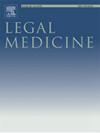Sequencing and ranking patterns of morphological dental features radiographically assessed for human identification
IF 1.3
4区 医学
Q3 MEDICINE, LEGAL
引用次数: 0
Abstract
Background
Highly distinctive patterns can result from the combination of dental features. These features are related to dental treatment, morphology or pathological conditions, and in human identification they can be optimally assessed by means of radiographic analysis. This study aimed to classify dental features and rank them based on distinctiveness.
Methods
The sample consisted of panoramic radiographs (n = 7212) of females (58,07 %) and males (41;93 %) between 12 e 22.99 years. The permanent teeth, except third molars, were analyzed in each radiograph. A 28-digit sequence was created with the following dental features: non-restored, missing, restored, presenting root dilaceration, impacted, rotated teeth.
Results
This study detected 2792 dental patterns (39 % of distinctiveness). The most common pattern was “all non-restored teeth” – corresponding to 30.4 % in males and 26.5 % in females. When a single tooth with rotation occurred, it decreased to 1 % the odds of finding an equal pattern. In general, males had a higher chance of presenting non-restored teeth compared to females (p < 0.05).
Conclusions
The distinctiveness of dental patterns was almost twice as high in the mandible compared to the maxilla. Distinctiveness increased with age with the occurrence of less non-restored teeth. Forensic odontologists must be prepared to assess radiographic features related to tooth morphology, especially in mass disasters that involve dental human identification of young individuals.
牙齿形态特征的序列和排列模式放射学评估,以供人类识别
背景:高度独特的图案可能是由牙齿特征的组合造成的。这些特征与牙科治疗、形态或病理条件有关,在人类鉴定中,它们可以通过放射学分析进行最佳评估。本研究旨在对牙齿特征进行分类,并根据特征的显著性进行排序。方法选取年龄12 ~ 22.99岁女性(58.7%)和男性(41.93%)的全景x线片,共7212张。对除第三磨牙外的恒牙进行x线片分析。建立了28位牙序列,具有以下牙齿特征:未修复,缺失,修复,呈现牙根扩张,阻生,旋转。结果共检出2792种牙型,识别率39%。最常见的模式是“所有未修复的牙齿”,男性占30.4%,女性占26.5%。当出现单颗牙齿旋转时,找到相同模式的几率降低到1%。一般来说,男性出现未修复牙齿的几率比女性高(p <;0.05)。结论下颌骨的牙型特征是上颌骨的2倍。随着年龄的增长,显著性增加,未修复的牙齿减少。法医齿科医生必须准备评估与牙齿形态学相关的放射学特征,特别是在涉及牙齿人类识别年轻人的大规模灾难中。
本文章由计算机程序翻译,如有差异,请以英文原文为准。
求助全文
约1分钟内获得全文
求助全文
来源期刊

Legal Medicine
Nursing-Issues, Ethics and Legal Aspects
CiteScore
2.80
自引率
6.70%
发文量
119
审稿时长
7.9 weeks
期刊介绍:
Legal Medicine provides an international forum for the publication of original articles, reviews and correspondence on subjects that cover practical and theoretical areas of interest relating to the wide range of legal medicine.
Subjects covered include forensic pathology, toxicology, odontology, anthropology, criminalistics, immunochemistry, hemogenetics and forensic aspects of biological science with emphasis on DNA analysis and molecular biology. Submissions dealing with medicolegal problems such as malpractice, insurance, child abuse or ethics in medical practice are also acceptable.
 求助内容:
求助内容: 应助结果提醒方式:
应助结果提醒方式:


